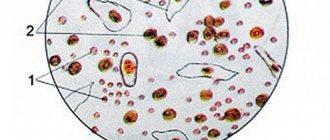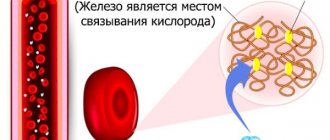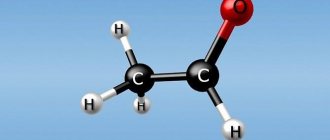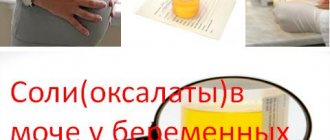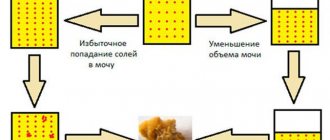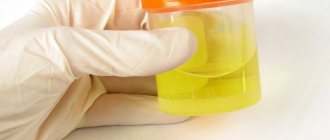How are they detected in urine?
Why a year-old child has no teeth - timing of appearance
If there are no symptoms indicating that the urinary system is affected, then oxalic acid salts can be detected in the urine during a general urinalysis (UCA). General urinalysis is a comprehensive study of the physical and chemical properties of urine, which also includes microscopic examination of sediment. Oxalates in a baby's urine are often detected during urine microscopy.
Note! The composition of the urine depends on whether the material for the study was collected correctly. It is worth listening to Komarovsky’s advice and not using empty food or medicine jars for collection. You only need to collect urine for analysis in special containers that can be purchased at the pharmacy.
How to normalize the level?
Therapy for the disease should be comprehensive and include the use of medications simultaneously with a therapeutic diet.
This is necessary to reduce the intake of oxalic acid into the body with food and normalize metabolism.
The following drugs are used in treatment :
- Membrane stabilizers - prevent the accumulation of calcium salts in cells and stimulate their excretion (vitamin A, vitamin E, Dimephosphone).
- Xidifon - regulates the level of calcium in the body and prevents the deposition of oxalates.
- Enterosorbents – promote the removal of oxalates from the intestines (Enterosgel, activated carbon, Smecta).
- Probiotics – have a beneficial effect on the intestinal microflora and normalize metabolism.
Nutrition is one of the most important elements in the treatment of oxaluria.
To begin with, you should give your child plenty of fluids to speed up the elimination of salts. Then you should exclude the following foods from your diet :
- sorrel;
- spinach;
- rhubarb;
- cocoa and chocolate;
- figs;
- smoked meats;
- spicy food;
- salt and salty foods;
- marinades;
- products containing gelatin;
- fatty soups and broths.
Foods high in vitamin B6 contribute to the elimination of oxalates , so they must be included in the child’s diet:
You should eat the following foods in moderation :
To obtain protein foods from your body, it is recommended to consume lean meats and fish. It is better to cook food boiled, then you can lightly fry it. It is allowed to stew food, but you still need to boil it first. This is necessary to reduce the formation of purine compounds in products.
In this case, you should eat little by little, but often (6-8 times a day). Small portions of food are digested faster and do not overload the body. Meals should be accompanied by plenty of drinking 30-40 minutes after the meal. To do this, it is best to use the following drinks :
- dried fruit compotes;
- Birch juice;
- herbal decoction (corn silk or dill);
- fresh fruit or vegetable juices;
- filtered and boiled water;
- special dietary water for children in bottles.
Oxalates in a child’s urine are a dangerous phenomenon. This may be a symptom of a serious illness , so it is necessary to carefully examine and treat the disease. If measures are not taken in time, there is a risk of disruption of the functioning of internal organs, and in the most severe cases, death is possible.
Find out from Elena Malysheva what products form urates and oxalates in urine:
Therapy for the disease should be comprehensive and include the use of medications simultaneously with a therapeutic diet.
Drug treatment of oxalate nephropathy
In pediatric nephrology, they are more common than other nephropathies; their occurrence is associated with a violation of the metabolism of oxalic acid and calcium in the body. In children with this type of pathology, increased absorption of oxalic acid occurs in the intestines, its excess in the form of salt (calcium oxalate) is excreted in the urine in dissolved form. However, remembering the school course in organic chemistry, we know that oxalates are soluble only in a slightly alkaline and neutral environment; when urine shifts to the acidic side, their solubility decreases and they precipitate in the form of crystals. Considering the type of diet and urine reaction of children, this is not uncommon among them.
Calcium oxalate crystals are white, hard to the touch and more often than other salts damage the urinary tract, which is accompanied by the appearance of red blood cells in the urine and pain. The crystals damage the baby's delicate kidney tissue, and fragments of kidney cell membranes (membrane phospholipids) may appear in the urine.
In the development of oxalate nephropathy, an important role is also played by the deficiency of B vitamins, which are involved in the metabolism of oxalic acid, promoting its utilization, vitamins A and E, which protect the membranes of the kidney cells from damage by oxalate crystals. Bacterial infections that disrupt the acid-base environment of urine, and hypervitaminosis D, which increases the excretion of calcium in the urine and its binding to oxalic acid, also have a negative effect. Predisposing to salt formation is the intake of foods rich in ascorbic and oxalic acids - sorrel, asparagus, spinach, beets, strawberries, tea, cocoa, chocolate, beans, walnuts, peppers. Heredity is also important: such children in their family have urolithiasis, stomach and intestinal diseases, and allergies. The risk of nephropathy increases in dry, hot climates, since with insufficient water consumption and active loss of water, urine becomes concentrated and oversaturated with salts.
Typically, such babies have periodic abdominal pain of unknown origin and imprecise localization; they are in no way related to meals and intensify after physical activity. In addition, parents may notice rare urination, the release of small portions of urine, a decrease in the total daily amount of urine, a tendency to more urine at night (so-called nocturia), and a whitish, chalky sediment may be detected in the settled urine. Outwardly, such children are usually slow. They may have a slightly increased body weight, they have disorders of the autonomic nervous system - sweating, marbling, cold extremities, impaired thermoregulation in the form of low-grade fever - up to 37-37.2 degrees C, and often have gastrointestinal disorders. Sometimes oxalate nephropathy can manifest itself exclusively as disturbances noted in urine tests, with the child’s general satisfactory condition.
Manifestations usually occur in early and preschool age. A urine test will note the presence of red blood cells, a small amount of protein, the presence of leukocytes, and in the absence of bacteria - the so-called non-infectious inflammation. The presence of crystals in the urine and a high specific gravity of urine - up to 1030 and higher - are mandatory.
The main task of treating oxalate nephropathy is to select an adequate diet. The baby’s diet should consist of a variety of food products of plant and animal origin, the ratio of proteins, fats and carbohydrates in the diet is 1:1:5. The content of B vitamins should exceed the standards by two times, and vitamin B6 by at least four times.
In the diet for oxaluria, Brussels sprouts, cauliflower, white cabbage, apricots, bananas, melons, pears, pumpkin, cucumbers, peas, all types of cereals, white bread, vegetable oil are allowed. Periodically - potato and cabbage diet.
Limited - carrots, green beans, onions, tomatoes, strong tea, beef, chicken, aspic, liver, cod, currants, Antonov apples, radishes.
Excluded: chocolate, beets, celery, spinach, sorrel, rhubarb, parsley, extractives (broths).
Enrichment of the diet with B vitamins and magnesium can be achieved by including wheat bran and dishes made from buckwheat, oatmeal, wheat groats, dried apricots, and baker's yeast into the diet. A decoction of wheat bran is recommended to be added daily to various dishes. Due to the fact that the smallest amount of salts precipitates at a pH of 6.5-6.6, the acidity of urine is regulated by a special selection of foods that balance the content of acidic and alkaline components in the diet; for this, an increased amount of potatoes, vegetables and fruits is introduced into the diet.
To ensure a normal amount of urine that prevents the precipitation of salts, children receive in addition to the diet decoctions of dried fruits, decoctions of herbs that have a diuretic effect (St. John's wort, bearberry, yarrow) and still mineral waters.
Drug treatment is prescribed for high oxalate levels in the urine or salt precipitation. They use pyridoxine (vitamin B6), which reduces the formation in the body and absorption of oxalic acid from food, vitamins A and E, which protect kidney tissue cells from damage, magnesium oxide - it acts in the intestines, forming sparingly soluble salts of oxalic acid and thus preventing , she gets sucked in. The duration of such courses ranges from 3 months to one and a half years, usually taking a 3-4 week break and monitoring urine tests. Naturally, treatment should be carried out under the supervision of a doctor.
In addition, the complex of therapeutic measures includes sufficient drinking and movement regime, and physical therapy.
The norm of oxalates in the urine of an infant
Vomiting water in a child under 1 year of age - what to do when he feels sick
As with any indicators, there are certain standards for oxalate in urine; they directly depend on the age of the child:
- For a baby up to one year old, the norm is 1-1.3 mg/kg per day;
- For children under 3 years old, a little - 0.5 mg/kg per day.
Additional Information. Elevated oxalates in a baby’s urine can be detected after a nursing mother ate salty or spicy food the day before. This will mean that the pediatrician must order a repeat test and advise the mother about her diet before taking it. If after the second analysis the diagnosis is confirmed, the doctor must prescribe treatment for the small patient.
Oxalates in the urine appear not only due to an ongoing disease in the body, they can also be detected for other reasons. When collecting urine for research, you need to carefully prepare for the test for the presence of oxalates. To do this you should:
- Collect all daily urine in only one, absolutely sterile container;
- There is no need to collect the first morning portion of urine; start collecting only from the second urination;
- The last portion of urine should be collected the next morning;
- Next, you need to mix all the daily urine in one container, take 100 ml and pour it into a special container for testing;
- Take the container with urine to the laboratory and write on it the total amount of urine per day.
Child's diet with oxalates
Treatment of oxaluria includes not only the use of medications, but also mandatory adherence to a diet. First of all, the child needs a special diet and drinking regime. Meals should be fractional. It is necessary to exclude or at least minimize foods that contain calcium, oxalic and ascorbic acids from the menu.
These products include:
- sorrel, spinach and rhubarb;
- citrus;
- plums;
- gooseberries and strawberries;
- cocoa and desserts made from it;
- large amounts of meat and sugar.
The child’s diet should be based on foods whose consumption helps remove oxalates from the body. Among them are:
- pumpkin;
- legumes;
- potato;
- cereals (buckwheat, oatmeal, etc.);
- vegetable oil;
- White bread;
- cucumbers;
- pears and bananas;
- dried fruits.
The child needs to drink at least 2 liters of purified still water daily. Tea is strictly contraindicated. It can be replaced with freshly squeezed fruit or vegetable juices, which are recommended to be prepared immediately before consumption. Store-bought juices will not work. It is better to drink the bulk of the liquid in the afternoon. This is necessary to prevent oxalate crystals from settling in the urine.
You need to stick to the diet for at least 3 weeks. After a month's rest, it is recommended to repeat the diet.
Urates in urine (uraturia)
List of prohibited products:
- all offal (kidneys, liver, brains, heart, ventricles, etc.), as well as young meat (veal, lamb, chickens, piglets, etc.) and fish;
- rich meat, mushroom and fish broths (since part of the purine bases goes into the broth during cooking);
- fried, smoked and salty foods (sausages, sausages, salted cheeses);
- animal fats (lard);
- vegetables and fruits with a high content of organic acids: sorrel, lettuce, spinach, parsley, green onions, currants, sour apples, etc.;
- sweets, chocolate, as well as coffee and cocoa;
- alcoholic and low-alcohol drinks;
- legumes;
- baked goods (pies, buns, etc.).
List of permitted products:
- milk and products based on it (cottage cheese, unsalted cheese, sour cream, etc.);
- sweet fruits and berries (raspberries, strawberries, strawberries, etc.);
- vegetables and vegetarian soups with them: cauliflower, potatoes, zucchini, squash, pumpkin, peppers, carrots, cucumbers;
- dried black and white bread (yesterday's baking);
- the amount of salt is reduced to six to eight grams per day, and the amount of liquid drunk (in the absence of contraindications) is increased to two to three liters.
Reasons for the appearance of oxalate salts
In breastfed babies, oxalates in the urine most often appear due to improper nutrition of the nursing mother, but this may also indicate a pathology of metabolic processes in the baby’s body. In addition, excess oxalic acid salts in the urine can occur due to congenital kidney disease.
Constipation in a 7-11 month old baby - causes and types
Oxalaturia is divided into two types:
- Primary;
- Secondary.
Primary – considered congenital, it occurs due to a hereditary disorder of oxalic acid metabolism in the body. Secondary - appears due to the development of certain diseases or the consumption of certain foods.
The non-pathological cause of oxalaturia is the consumption of foods rich in oxalic acid by a nursing mother. These include tea, spinach, rhubarb, beets, and chocolate.
Important! A nursing mother should know that all the nutrients and toxic substances from the foods she eats get into her milk.
Also, reasons for the appearance of more than moderate amounts of oxalates in the urine of a child include:
- Congenital disorders in metabolic processes in which oxalic acid takes part. As a result, its removal from the body is disrupted;
- Inflammation of the kidneys or intestines;
- Diabetes;
- Stones in the kidneys;
- Various chronic pathologies;
- Lack of B vitamins;
- Dysmetabolic nephropathy. It appears due to hereditary predisposition or certain mutations in the baby's genes;
- Dehydration, which is caused by prolonged exposure to the hot sun, intestinal infection, fever with increased sweating and insufficient drinking regimen for infants.
Oxalaturia
Types of uric salts:
Oxalates
. Most often found in the urine of a child. They can be caused by diseases of the urinary system, various inflammations, stomach ulcers, poisoning, as well as an excess of vitamin C in the diet (citrus fruits, chocolate, sorrel, etc.) and a lack of other vitamins (E, A, group B).
Urats
. Externally, these salts look like a dark red sediment in the urine. The reason for the increased content of urates in a child’s urine is poor diet - a large amount of meat, fish products, legumes, chocolate, as well as a lack of fluid in the body. Sometimes the presence of urates indicates certain blood diseases.
Phosphates
. They can be detected in urine even in the absence of diseases, for example, due to overeating. In this case, the pH level is disrupted, the acidity of the urine decreases, and the phosphate content increases. The amount of these salts is also affected by the diet: an abundance of foods rich in phosphorus, abuse of alkaline mineral water.
Treatment of childhood oxaluria
In order to not only eliminate the disease itself, but also the cause, and prevent the appearance of oxalates, complex therapy is prescribed
In order to not only eliminate the disease itself, but also the cause, and prevent the appearance of oxalates, complex therapy is prescribed. This includes medication, diet, sleep and drinking habits.
The prescription of medications directly depends on the cause of the illness; as a rule, children are prescribed medications:
- containing antioxidants and membrane stabilizers;
- potassium and magnesium salts, which normalize urine and shift it to the acidic side.
As a mandatory element, a diet is needed for oxalates in the urine, and it is also prescribed by the doctor. Compliance with diet and drinking is therapy aimed at removing acid salts and normalizing metabolic processes. For at least 2-4 weeks, the diet is strictly followed, then a break is allowed, and then the diet is repeated.
The standard diet for children with oxaluria contains the following restrictions and requirements:
- minimal consumption, or better yet, complete exclusion of products containing oxalic acid (listed above);
- an increase in meat and dairy products in the diet, but in the amount recommended by the doctor and only in the first half of the day;
- supplementing the diet with cabbage, apricots, peas, eggplants, apples, pumpkin, currants, bananas;
- reduction in salt and sugar content;
- reduce beans, carrots, dried and smoked foods, tomatoes, onions in the diet;
- supplementing the diet with cereals, pasta, pastries, butter, cheese (hard spicy varieties with caution).
Important! Partial meals are required: 5-6 times a day in small portions of no more than 300 grams. in one go.
Fasting potato-cabbage days are allowed no more than 2 times a week
Fasting potato-cabbage days are allowed no more than 2 times a week. The combination of products has a beneficial effect on the body and helps normalize metabolic processes.
Compliance with the drinking regime is also a mandatory procedure. Children need to drink quite a lot and often to flush out excess oxalic acid. Doctor-recommended mineral water, cranberry-lingonberry fruit drinks, pear and cherry infusions and flaxseed infusions are suitable. You don’t need to drink a lot right away, but your baby should drink about 1.5-1.8 liters per day. liquids, including soups and fruit juices.
Important! The drinking regime should be observed only on the recommendation of a specialist, since in case of kidney disease a lot of liquid is harmful!
Oxaluria is an insidious and dangerous pathology. Mild or absent symptoms and extensive causes do not always make it possible to suspect the disease. But if oxalates are found in the urine, you definitely need treatment! Lack of therapy, neglect of recommendations and violation of the regimen increases the risk of urolithiasis, renal failure and other dangerous ailments. Therefore, if the analysis shows salts, you should exclude the products listed above and get tested again. If salts are present again, the pathology must be treated without delay.
Source
03-med.info
Oxaluria is a special type of manifestation of urolithiasis. This type of disease occurs when there is an excess of insoluble salts and calcium oxalates. This mainly occurs due to a violation of material metabolism.
Also, this disease can be inherited, occurring in people who abuse food containing oxalic acids, lead a passive lifestyle, or have an unstable, poorly balanced diet. Unfortunately, oxaluria often occurs in children. Insoluble salts can be deposited in all parts of the urinary system, giving a person a lot of unpleasant and painful sensations and inflammatory processes. Also, during this disease, a person urinates more frequently.
The presence of stones in the urinary system is very dangerous. Since they cause significant damage to the tissues of the kidneys, bladder and ureters. In rare and severe cases, the patient may even lose a kidney. The diet for oxaluria in children and adults has the same structure. The only difference is that the child must be constantly monitored and his diet must be worked on.
Diet for oxaluria plays a vital role for children. Together with medications, surgical interventions and therapy, diet is an important process in the treatment of the disease. Proper nutrition can significantly improve a child's health and significantly prevent the formation of new stones. Also, with the help of a well-chosen diet, you can restore balance in the body.
For example, during a therapeutic diet, meat and fish must be boiled, and only then baked or fried. This is done in order to reduce the intake of purine compounds, which are found in large quantities in these foods. There is also a strict restriction on the consumption of animal fats and butter.
So, if a disease such as oxaluria is discovered in a child, the diet strictly prohibits the use of:
- all foods high in oxalic acids (spinach, figs, cocoa, chocolate, sorrel, rhubarb, purslane);
- dishes containing fat, as well as all smoked, pickled, hot, salted and spicy foods;
- highly rich and fatty broths (soups) from poultry, fish and meat;
— gelatin-containing products (aspic, jelly, jelly, marmalade);
Also, the oxaluria diet involves limiting the amount of the following foods:
- from vegetables: potatoes, tomatoes, carrots, onions, beets (in any form);
- from berries: black currant, blueberry.
The oxaluria diet is formed from the most suitable products that can support the body and improve its health. The list of products recommended by doctors includes:
- all fruits that help remove harmful oxalates from the body (pear, quince, dogwood, apple, plum);
- all foods high in vitamin B6 (buckwheat, barley, pearl barley, millet, liver);
- all products with a high content of magnesium (wheat bran, apricots, seaweed, millet, prunes, oatmeal);
- products rich in pectin and fiber.
In addition, the diet for oxaluria involves reducing the consumption of carbohydrates and table salt. It is advisable to fill the child’s daily menu with a large number of vitamins of natural origin and add multivitamin medications. If the patient has no contraindications, then the diet should include a decoction of rose hips and fresh juices from fruits and all kinds of vegetables. The number of daily calories for an active child is three and a half thousand units.
A very unpleasant and uncomfortable disease is oxaluria in children; diet can cure it. Of course in the early stages. But even in difficult cases, it plays a very important role. It is necessary to constantly monitor the child’s nutrition. It is advisable to draw up a menu for the week in advance in order to properly distribute and balance all the necessary substances, vitamins and various microelements.
With a developed child feeding system, it will be much easier to track the dynamics of recovery or progression of the disease. It is very important to record the foods you eat throughout the day. This will make it easier to identify erroneous points.
It is best to develop a child’s nutrition chart together with a doctor who monitors the progress of recovery. A specialist will be able to suggest the most useful products in a particular case and point out errors.
provizor.org
Treatment of urate nephropathy in children
This type of nephropathy develops less frequently. Usually, urate salts in urine are detected against the background of various diseases, although the development of urate nephropathy as an independent disease is possible. The appearance of a brick-red sediment in freshly released urine indicates the release of uric acid and its salts. Pathology occurs when the metabolism of purines (certain sections of DNA, RNA and proteins) is disrupted. It is part of the so-called neuro-arthritic diathesis. Children with this pathology have certain enzymatic defects that form metabolic disorders not only of uric acid and its salts, but also of carbohydrates and fats. As a result, acetone syndrome with vomiting and abdominal pain may also form. In addition, these children also have peculiarities in the functioning of the nervous system.
Boys get sick 2.5 times more often than girls, and in families such children often have kidney pathologies, urolithiasis, gout, arthritis, hypertension and coronary heart disease, diabetes mellitus, diseases of the stomach and intestines, and gall bladder. Often, metabolic features are inherited from parents or close relatives along with allergies. Symptoms are most pronounced when you start attending kindergarten or school, when stress occurs more often. The course of nephropathy is aggravated by infections, errors in nutrition and consumption of fatty and high-protein foods. The influence of the environment is also very noticeable - sharp temperature fluctuations, exposure to the open sun, poor-quality drinking water with a large amount of calcium salts (hard water), fluoride and iodine deficiency can be a provoking factor.
Clinically, nephropathy manifests itself in the form of changes in urine - a high urate content, up to brick-red coloring of the urine, high levels of ammonia and acetone in the urine, a small amount of protein. Leukocytes appear in the urine, which indicate inflammation in the kidney tissue, red blood cells, which characterize damage to the kidney tissue by crystals and a change in pH to the acidic side (which helps reduce the solubility of urates and the formation of stones).
Such children have a neurasthenic syndrome in the form of emotional instability, irritability, variability of behavior - stubbornness, negativism, aggressiveness. Night terrors, various tics, stuttering and enuresis occur less frequently. Children with a neuro-arthritic constitution and urate salts often have a body weight deficit of more than 10% due to decreased appetite, various allergic rashes, and paroxysmal abdominal pain. In most of them, examination reveals stomach diseases with increased acidity, intestinal disorders, biliary dyskinesia, urinary disorders, and acetone crises occur. Adolescents may also experience increased blood pressure.
Treatment of urate nephropathy is carried out according to the same principles as oxalate nephropathies. The first place in treatment is adjusting the diet. The volume of urate salts excreted in the urine depends on the baby’s body weight and the purine content in food. In this regard, it is recommended to maintain a stable weight by limiting animal proteins and fats, as well as limiting foods containing many purines. Allowed are dairy products in the first half of the day, potato and cabbage diet. Cauliflower and white cabbage, cereals (buckwheat, oatmeal, millet, rice), fruits, dried apricots, prunes, seaweed, wheat bran, butter and vegetable oil, wheat bread, wholemeal rye bread. Lean meat and fish - 3 times a week, 150 g for older children, boiled in the first half of the day. Limited to peas, beans, beef, chicken, rabbit. Excluded are strong tea, cocoa, coffee, chocolate, sardines, animal liver, kidneys, brains, lentils, pork, offal, fatty fish, meat and fish broths.
The diet includes foods containing proteins of plant origin, as well as those that contribute to the alkalization of urine (vegetables, especially potatoes, fruits with a high fiber content). Cereals, eggs, rice, and milk contain almost no purines. Fruit, potato and dairy diets are most recommended as fasting diets for excess salts. Lemon can be used in food to dissolve stones in combination with an alkaline drink.
Treatment of nephropathies with impaired purine metabolism includes a mandatory effect on metabolic processes. Since the solubility of acids is largely related to the pH of the medium, which is regulated by the volume of water, to increase the solubility of urates it is necessary to increase the volume of daily urine; with low urine density (1010 or less), crystals do not precipitate at all. Therefore, children are advised to drink plenty of fluids in order to increase diuresis (the amount of urine). Moreover, the distribution of fluid throughout the day should be uniform and correlated with the amount of food taken. The volume of drinking is approximately calculated - at least 120 ml per kg of body per day. It is important to maintain the volume of fluid you drink at night, when the urine is more concentrated, which creates the preconditions for salt crystallization.
In addition to drinking regimen and diet, attending physicians prescribe medications that affect salt metabolism. Treatment is continued for a long time - from one and a half to months, under the control of urine pH using special test strips. Alkaline mineral waters are also prescribed. For active separation of urine and prevention of stagnation, a sufficient motor regimen and physical therapy are prescribed.
Advertising
Symptoms of oxalaturia in children
Parents should pay special attention to the baby’s health in this case:
Note! If even some of the above symptoms occur, parents should consult a pediatrician as soon as possible and ask for a referral for a general urine test. If the diagnosis of oxalaturia is confirmed, appropriate measures should be taken immediately and treatment should begin.
How are children with nephropathy monitored?
Children with all types of nephropathies are monitored in the clinic by a pediatrician and a nephrologist. Hospitalization in a hospital is required only in case of complications - pyelonephritis, urinary tract infection, stone formation, or in case of a detailed examination to determine the cause and clarify the diagnosis.
Children with dysmetabolic nephropathy, depending on the condition, are assigned health groups from IIb to IV. Such babies are examined by a pediatrician monthly during the first year of observation, then once every three months, and by a nephrologist - once every six months.
Children take the necessary tests and undergo examinations - urine analysis is monitored monthly. Moreover, it is desirable to determine the nature of the urinary sediment and the size of salt crystals. A Zimnitsky test is performed, which gives an idea of the concentrating ability of the kidneys, and an ultrasound of the kidneys and bladder is performed. If necessary, the doctor may prescribe an X-ray examination using contrast agents.
Sometimes the doctor asks parents to monitor urine pH at home with special test strips and record the results. These data make it possible to adjust the diet and dosage of medications.
Dispensary observation is carried out before the child is transferred to an adult clinic.
Advertising
Possible complications
Untimely or lack of any treatment can lead to the accumulation of salts in a small body, this will provoke serious complications. The child's oxalates will gradually accumulate in the kidneys and begin to form crystals, sand and stones. The resulting stones lead to blockage of the urinary canals, this will be accompanied by very severe and sharp pain.
The sharp edges of the crystals will injure tissue and lead to bleeding, pyelonephritis, disruption of the proper functioning of the kidneys and other diseases that cause inflammation of internal organs and tissues. Without appropriate treatment, the baby may experience kidney failure, metabolic disorders, and blockage of the urinary system.
Prevention, features of the breastfeeding diet
Elevated levels of oxalates can be detected regardless of age. Very often they are found in the analysis of a breastfed child. Oxaluria is very closely related to the diet of a nursing mother, because all the foods she consumes enter the baby’s body with breast milk. Also, excessive formation of oxalates can occur due to pathological processes in the kidneys, congenital metabolic disorders, and unfavorable hereditary factors.
There are very few nursing mothers who follow a certain diet during the breastfeeding period. Their food is familiar, without restrictions in anything, they do not follow any diet. As a result, the baby's oxalate levels may rise above normal.
If the baby is breastfed, the nursing mother must adhere to a proper and balanced diet so as not to harm her baby’s body.
If oxalates are detected in a child, the mother should exclude sources of oxalic acid from her diet:
- Rhubarb;
- Sorrel;
- Spinach;
- Beetroot;
- Products containing cocoa;
- Parsley;
- Onion;
- Radish; rutabaga;
- Citrus;
- Sour berries;
- Plums;
- Almond;
- Green beans.
In addition, you should give up sour fruits, tomatoes, liver, coffee, and strong tea. It is equally important to reduce your salt intake. If the disease progresses significantly, you need to limit your diet to foods that contain large quantities of calcium: dairy products, greens, legumes, cereals, flour products. The minimum period for following the diet is two weeks.
The mother’s diet must contain foods that contain vitamins A and B, magnesium, potassium, and protein. It is very important to eat grapes, quince, cabbage and potatoes, bananas, cucumbers and pumpkin, dried fruits, pears and apricots, vegetable oils and meat.
Important! Parents must organize a proper sleep and rest schedule for the child, which includes sufficient activity and walks in the fresh air. The children's room should be kept cool and moderately damp. Regarding the environment, it is important to provide the child with psychological comfort.
Oxalates are detected very often in urine tests in infants. Parents don't need to worry right away. This happens when the baby’s mother violates the diet or collects urine incorrectly for analysis. If the diagnosis is confirmed again, it is important to follow all the doctor’s recommendations: follow a proper diet and take medications.
What to do with oxaluria
If an excess of the normative level of oxalates in a child is detected for the first time, there are no symptoms of impaired functioning of the kidneys or other organs, doctors recommend non-drug correction of the condition. It involves strict adherence to the diet by the child or mother of a newborn baby.
Diet food
Prohibited products include:
- all legumes;
- spinach;
- celery;
- sorrel;
- strawberry;
- tomatoes;
- radish, radish;
- sour apples;
- cocoa, chocolate;
- currant;
- coffee;
- strong black tea.
It is necessary to minimize your child's consumption of the following foods:
- rich broths from meat, fish, mushrooms;
- herbs, spices;
- canned food, smoked meats;
- marinades and pickles;
- confectionery products, baked goods made from premium flour;
- hard cheeses.
It is allowed to eat bread made from rye flour with the addition of bran. The basis of a diet with a high oxalate content is porridge cooked in water. You are allowed to eat a little lean meat, chicken, turkey or fish, boiled or steamed, every day. Boiled or baked potatoes are served as a side dish. Salads made from fresh cucumbers and cabbage must be on the table. The child needs to eat fruits - bananas, pears, apricots, quince.
Be sure to drink a lot. Doctors recommend making dried fruit compotes for your baby without adding sugar (it’s better to get rid of the sweetener altogether or replace it with honey). Alkaline mineral waters without gas are useful.
Dietary nutrition should include components rich in vitamins A, B, E, minerals - magnesium and potassium. The intake of vitamin C, D, and calcium is strictly limited. Table salt should be practically eliminated during the treatment period.
The diet must be followed until the urine test normalizes. Then the child’s diet is gradually expanded. This is done gradually, over 3-4 weeks.
Fluid intake regimen
To normalize the oxalate content in a child’s urine, it is necessary for him to drink a lot of fluid. The minimum volume of water drunk daily for a preschooler should be one and a half liters.
An abundant supply of fluid stimulates the process of dissolution of oxalic acid salts and their elimination.
To normalize the composition of urine, you can offer your baby not only water. Fresh juices and berry fruit drinks help well in treatment. Uzvars made from dried fruits (apples, pears, raisins) are especially useful. They are rich in potassium, magnesium, and glucose. Kids enjoy drinking such compotes.
It is difficult for a child to drink a large volume of liquid at a time, and this is not necessary. Doctors recommend offering children (especially babies under one year old) drinks in small portions at intervals of 40-60 minutes. Be sure to give your baby something to drink half an hour before meals and 40-45 minutes after meals.
If necessary, the specialist will recommend a suitable plant and explain how to prepare a healing drink from it. The restriction on the use of herbal remedies is due to the fact that children are more sensitive to the active substances in medicinal herbs. Their dosage differs from that prescribed for adults.
If you have oxaluria, your child may drink alkaline mineral water. But the doctor must pick it up. The wrong choice of medicinal fluid can cause a worsening of the condition.
Recipes for oxaluria
Preparing food for a child who has high oxalate levels is not difficult. The main condition is to use products from the list of permitted ones, prepare dishes by boiling, baking or steaming.
Potato soup with buckwheat
You will need 1 liter of water, 2 tbsp. spoons of buckwheat, 3 medium-sized potatoes, ½ carrots, ½ onion, 2 tbsp. tablespoons butter, dill, bay leaf, ½ teaspoon salt.
The sorted and washed cereals are poured with water and cooked until half cooked, adding butter. Then throw the potatoes, cut into small cubes, into the water and let them boil for 10-12 minutes. Add finely chopped onion and grated carrots and cook for another 6-7 minutes. Season with salt, bay leaf and finely chopped parsley.
Baked fish with vegetables
Remove the fillet of lean sea fish from small bones. Sprinkle lightly with soy sauce and let marinate for 30 minutes. Line a frying pan with a high side with food foil and grease with butter. Place a layer of carrots cut into slices and thin slices of potatoes. Lightly salt. Place the fish skin side down on the vegetables, seal the food by connecting the ends of the foil. Place in an oven preheated to 200 degrees for 10 minutes, then reduce the heat and bake the fish for another 15 minutes. Serve with fresh cucumbers, yogurt and dill sauce.

